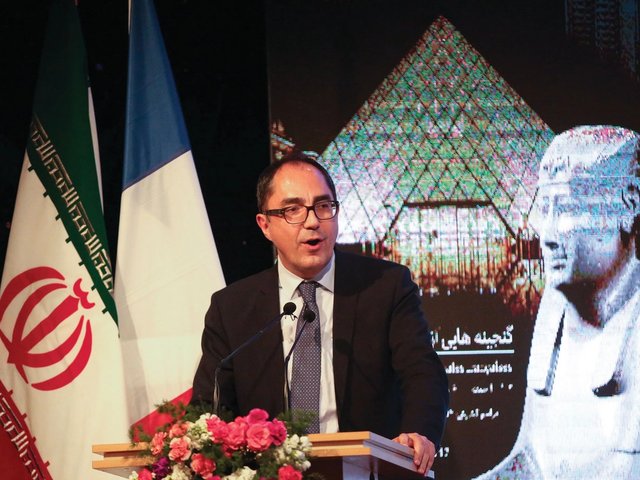When Islamic State (IS) began ransacking museums and destroying archaeological sites in Iraq, French president François Hollande organised an impromptu visit to the gallery in the Louvre, that houses the monumental, winged, human-headed bulls from Khorsabad and the Assyrian reliefs from Nimrud. He was pushed by archaeologist and historians of the Middle East, including Francis Joannès, a professor of ancient history at the University of Paris, to take a stand. Clearly improvised at the last minute, his visit the Paris museum was mainly a public relations exercise. But Hollande did announce that the Louvre would send a mission to Baghdad to help assess damage to national heritage and would organise an exhibition on Mesopotamia.
Offer of support
By offering such support, the Louvre joins the British Museum in London and others in a movement against what the French leader called “terrorist attacks on culture”. Delivered on 18 March, his speech was all the more dramatic because it was delivered as reports came in of the attack at the Bardo Museum in Tunis; a mission of experts from the Louvre had left the Bardo just 30 minutes before the shootings started. A few weeks later, Jean-Luc Martinez, the president of the Louvre, explains his plans in more detail to The Art Newspaper. As an archaeologist—a specialist in Greek and Roman antiquity—he feels a deep sense of solidarity with the Iraqi and Syrian people and revulsion over the wanton destruction of their cultural heritage, from “one of the first great civilisations that gave birth to urbanisation, writing and rule of law”.
Martinez describes this as a “turning point” for the Louvre and other encyclopaedic museums. “It is a chance that the universal museums must seize; to put themselves at the service of others in the most dramatic circumstances, and share the benefits of the work done by the diplomats of the 19th century who revealed these ancient cultures to the world.” He refers to the mission as a return to “diplomatic archaeology”.
The mission to Baghdad announced by Hollande will begin “before the summer”, Martinez says. The exact dates and circumstances of the trip are to be kept secret for security reasons. He insists that the curators and scientists that make up the Louvre team will concentrate on assessing the needs of their counterparts in Iraq. “The Iraqis are on the front line of the defence of their cultural heritage. They moved and secured most of the Mosul Museum’s collections. We are certainly not going to give them any lessons. We are there to help them, and the first step is to understand their needs,” he says. The Iraqis will also be invited to Paris.
A show on Mesopotamia
Meanwhile, on 1 June, the Louvre is due to host a meeting with the International Council of Museums (Icom), to establish a “red list” of artefacts from Iraq and Libya. The Louvre opened its archives and collections to help define the list.
Martinez confirms that an exhibition on Mesopotamia will be held in autumn 2016 at the Louvre’s northern satellite in Lens. He hopes it will include sculptures from the Iraqi National Museums. The Paris museum has also promised to help train young Iraqi archaeologists.
The Louvre, he says, has a historical legitimacy to stand beside the people in the Middle East. “It was the first, in 1847, to open an Assyrian Museum, which had a great impact all over Europe,” he says. Thanks to excavations led by France in Iraq, Syria and Iran, the Louvre has the Western world’s most comprehensive collection on Mesopotamia, spanning four millennia, from Sumer to the great Assyrian empires. Six French archaeological missions continue to work “in very difficult conditions” in Kurdistan, he says. And it was the Louvre that Tunisia’s Bardo Museum turned to for help in compiling the inventory for, and restoration of, its Roman sculpture. A protocol to renew this programme was signed on 18 April in Tunis.
Planned Assyrian exhibitions The Oriental Institute of the University of Chicago and the Field Museum in Chicago are opening shows in May that illustrate connections between endangered objects in the Middle East and their collections. “The sad thing is, it is moments like this when people become most interested in our museum,” says Jack Green, the chief curator of the Oriental Institute Museum. “We’re trying to show the public what they can do, which is to educate themselves and advocate.
The Louvre announced in March that it is organising an exhibition on Mesopotamia, including the Assyrian empire, at double-quick speed. Due to be held in the autumn of 2016 at Louvre-Lens, its satellite in northern France, the institution hopes to include artefacts on loan from Iraq.
The Rijksmuseum van Oudheden in Leiden began planning Europe’s first major exhibition about Nineveh six months ago. Due to open in November 2016, the director of the Dutch national museum of antiquities has increased the security budget for the show, which he hopes will include loans from the Met, the Louvre, the British Museum and the Berlin State Museums, among others.
The British Museum in London is in the early stages of planning a mayor exhibition on the Assyrians, which could take place in 2018. It will focus on Ashurbanipal, who came to the Assyrian throne in 668BC, built the North Palace at Nineveh and amassed a great library of cuneiform tablets. The famous lion hunt reliefs, some of which are now in the UK museum, formed part of his new palace’s decoration.
– J.H. and J.P.



